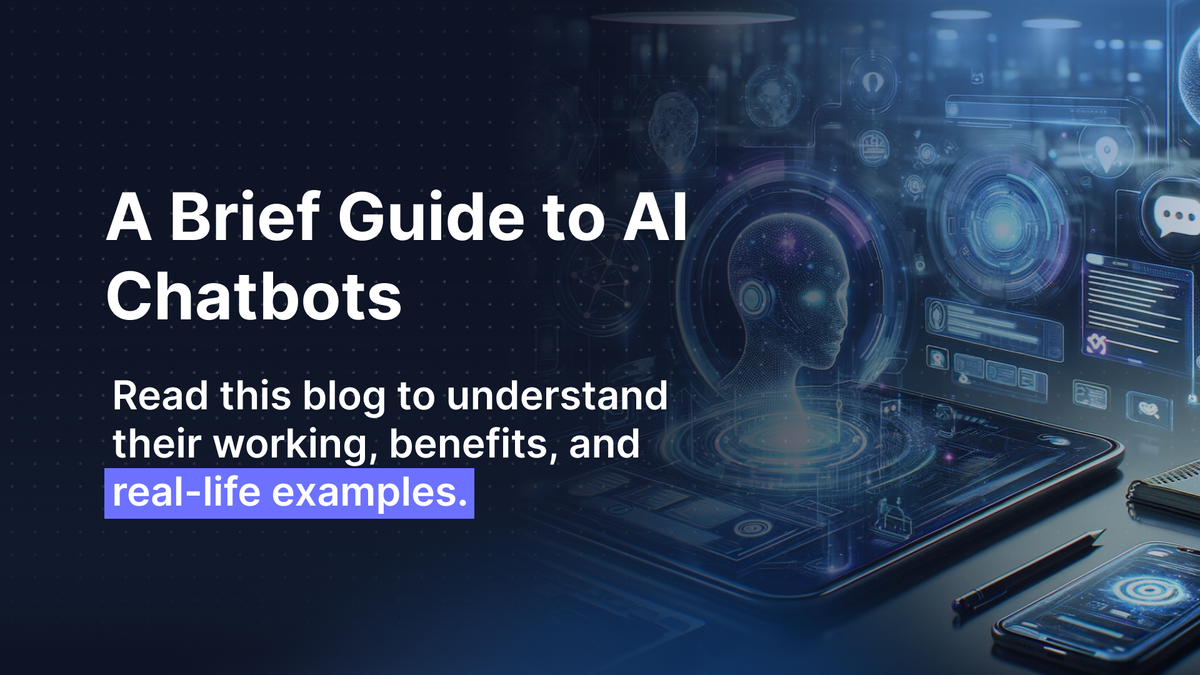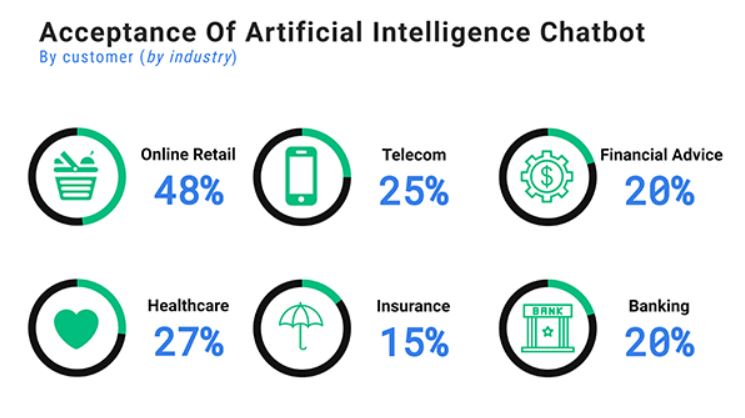Discover how AI chatbots are transforming customer service in 2024. Read this...

It's 2024, and we are interacting with AI chatbots on a daily basis. Whether it's the mundane task of ordering food, making online payments, or scheduling a complex medical appointment, these applications are transforming the world around us.
Today, chatbots have become the first line of interaction between businesses and their customers. You will hardly notice a company that is not using chatbots for 1:1 conversations with their customers. The global chatbot market size is expected to reach USD 34.2 billion by 2032. Chatbots are becoming better with every passing day, automating various business tasks such as customer service, sales, marketing, and lead generation, to name a few.
Stay with us till the end of this guide if you are curious about the workings of chatbots and how your business can utilize them in the best possible way.
A Brief Guide to AI Chatbots
What Is an AI Chatbot?
Understanding The Working of AI Chatbots
The Use of AI Chatbots In Different Business Areas
Real-life Examples of AI Chatbots
Conclusion
AI chatbots are software programs that can communicate with users in a free-flowing manner, like a friend or an acquaintance. They are designed with the help of NLP (natural language processing) and machine learning. These technologies help chatbots to understand and respond to users' queries in a natural and engaging way.
Today, AI chatbots interact with 1.5 billion people through different mediums such as websites, mobile apps, and social media messaging apps. These interactions take place in both text and voice formats. Unlike rule-based chatbots, AI chatbots can understand human intent better and provide accurate and speedy responses as per users' requirements.
An artificial intelligence chatbot works through four stages during its interaction with users. Lets understand it with the help of an example. Emma is looking for a stylish winter coat on a famous clothing website. Here is how the chatbot 'Fit Finder' will help her:
Emma: "Hi, I am looking for a warm winter coat."
Fit Finder: "Great! What kind of coat are you interested in? We have trench coats, parkas, and puffer jackets in our new collection."
The moment Emma shared the query, the chatbot started using NLP to analyze it. It breaks down the words and identifies the main keywords in them, such as 'warm' and 'winter coat.' This helps them to provide an accurate and focused response.
Emma: "I need something warm and stylish, maybe a puffer jacket."
Fit Finder: "Sure, we have a variety of puffer jackets. Please let me know your preferred size and color."
The chatbot generates a suitable response using machine learning algorithms. This includes matching the user intent and showing relevant information based on their preferences.
Emma: "I would prefer something black or navy blue in medium length."
Fit Finder: "Here are some medium-sized black and navy blue puffer jackets. I can also show you customers' reviews and recommendations for them."
The chatbot filters options based on the user's specifications and also provides additional information. It increases user satisfaction and improves future interactions.
Emma: "The navy blue puffer jacket with hood looks great. Please tell me more about its features."
Fit Finder: "Sure, the jacket is water resistant with a fur lining for extra warmth. Would you like to browse similar styles?"
Chatbots continuously collect data from user interactions to improve the NLP models and response generation with time. They are able to understand a user's intent and provide more accurate and personalized responses.
AI chatbots are being extensively used in different industries, such as banking, healthcare, and real estate, with E-commerce at the top of the list. Let's see how chatbots are helping businesses provide proactive customer support, enhance marketing experience, and improve sales.

Customers' demands for proactive service are on the rise. People don't have time for long waiting hours and want an immediate resolution to their problems. This is where chatbots take the lead by transforming traditional customer service into proactive 24/7 support. Chatbots can handle up to 80% of routine customer queries. This is because:
The use of AI chatbots is not limited to customer service. As we have discussed, chatbots are continuously storing data with every customer interaction. This data contains invaluable information about your customers, which can be utilized in different ways, such as:
Personalization and tailored recommendations can highly increase the effectiveness of marketing campaigns. This is why 36% of companies have turned towards chatbots to improve their lead generation.
Chatbots are a highly effective tool to get valuable feedback from your customers. This feedback can be exercised in different forms, such as ratings, comments, surveys, and polls. AI chatbots help automate and analyze data in a highly precise way. You can get access to your customer's behavior, needs, pain points, and expectations with your business.
This feedback helps you evaluate your business performance and improve your customer experience. Collecting customer feedback through chatbots can save you from spending large sums on pricey and time-consuming market research.
Above are just a few examples of how AI chatbots help you save time and resources and achieve your full business potential. However, careful planning, integration with existing systems, and continuous monitoring are essential for a successful implementation.
Let's take a look at some real-life examples of how different businesses are utilizing chatbots to achieve their business goals.

Booking.com is a global online traveling platform. They have recently launched a trip planner on their website. It is an AI-powered chatbot that enables users to plan their trips and vacations. It helps users with a wide range of travel queries such as flights, accommodation, car rentals, and sightseeing.
Erica is a virtual assistant chatbot by Bank of America. It is also one of the first chatbots in the banking and finance industry. Erica helps customers with their account balance, money transfer, bills, payments, and card management. The most significant benefit is that customers can access banking services anytime and anywhere without physically visiting the bank.
Nike, the leading American footwear brand, also has an AI chatbot available on their website and mobile app. This virtual assistant helps customers with product recommendations, FAQs, order tracking, and refunds and exchanges. Nike's chatbot also guides customers with personalized recommendations based on their preferences or past purchases.
More and more business industries are moving towards AI support. Chatbots are here to stay, and only those who leverage their full potential will be able to thrive in the future. AI chatbots are capable of transforming your customer service along with boosting your sales and lead generation. Using AI chatbot customer service helps you stay connected with your customers and provide them with personalized support and increased efficiency.
Are you planning to switch to AI automation for your business? Look no further and connect with Aidbase. Our AI-powered chatbot system is designed for an outstanding customer experience, and it never sleeps!